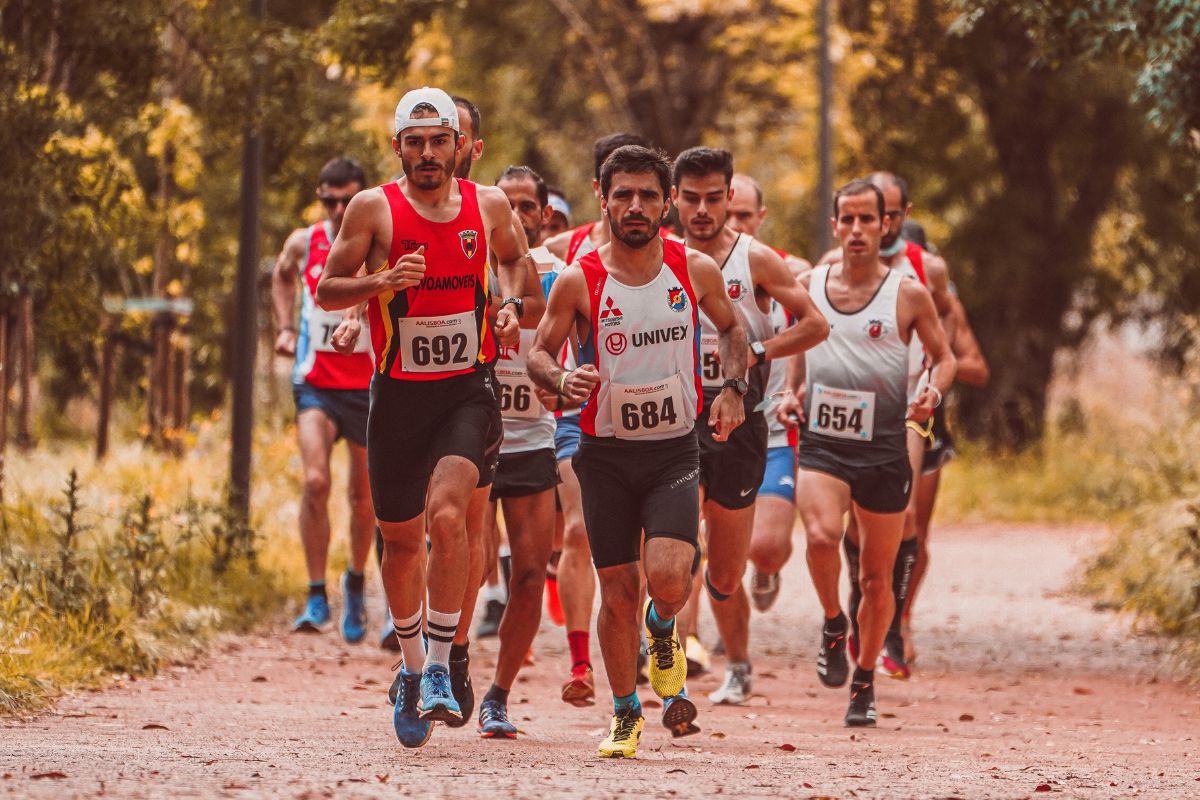When it comes to running, quality is way more important than quantity. You may be itching to reach your fastest speeds, but if you attempt this in the wrong way, you may end up with injuries that will prevent you from running full-stop.
It is important that you consider using proper forms and techniques while running. This will help you improve in the long run, helping you along the way to becoming a better runner.

In this article, we will look into proper running forms and techniques, and how to improve while running.
So, let’s get started.
Perfecting A Proper Running Form
You should first grasp what an appropriate running form is in order to fully understand how to run correctly, and how to master these skills.
This will have an impact on how you run moving forward (no pun intended).
Running with the best form and technique means using the least amount of energy, and putting the least amount of strain on your muscles and joints.
If you ignore these factors, you will definitely end up with an injury or two during your running… and, no one wants that. It is not fun!
Your posture, arm swing, footstrike, and cadence are just a few of the many factors that come together to establish the greatest running form and technique possible.
The Benefits Of Proper Running Forms And Techniques
Knowing and understanding proper running forms and techniques are crucial skills for a runner to have, since they promote more effective range of motion and muscle engagement.
As a result, you’ll be able to run more effectively, and experience fewer overuse illnesses and injuries, such as runner’s knee, IT band syndrome, and more.
For athletes who run farther or more frequently—between 10 and 30 miles per week—proper running form and technique are especially crucial. If you don’t pay attention to your form, you will definitely end up injuring yourself at some point.
There are several benefits that come along with knowing proper running forms and techniques.
Improves Your Athletic Ability
Knowing how to run properly will improve your athletic ability, meaning that you will be able to run for longer periods of time without getting worn out.
Your energy levels will improve, and your whole body will become stronger as you get used to using the correct muscles.
Improves Your Ability To Run Efficiently
Not only will you be able to run for longer periods, but you will also feel the difference in your body! Once you learn how to run using a proper form, you will feel the difference almost immediately.
Improves Your Running Speed
Unless you are training for a marathon, running is more about quality than quantity. It is much better for you to run at a slower pace and steering clear of injuries, rather than beating your top speed while ending up with a sprained ankle.
However, once you master a proper running form, you will begin to run faster. Then, you can achieve both quality and quantity!
Reduces Your Risk Of Receiving Injuries While Running
The main injuries that runners face are mostly avoidable. While we can’t help it if we trip over, we can avoid sprains and pulled ligaments by learning how to hold ourselves while we run.
Improves Your Overall Health
It is no secret that running is great for your health, both physically and mentally. However, when you learn to run with a proper form, your health will increase even further.
The 6 Essential Elements Of A Proper Running Form
When learning how to run ‘properly’, there are 6 very important factors that you need to consider. While running, make sure you think about each of these elements to ensure that you are running to the best of your ability.
1. Holding A Proper Posture
In order to have good posture, you must train your body to sit, run, and even walk in a particular manner.
The ideal postures are those that cause ligaments, tendons and muscles the minimum amount of stress while moving.
Maintaining proper posture while running is essential to prevent muscular imbalances, which frequently result in damage to your body.
Plenty of us develop terrible alignment habits from spending all day sat at a desk. It’s natural to lean over and drop your shoulders and head when you’re sitting down all day, and the same rules apply to runners.
Once you have worked out a proper posture while running, half the battle has already been won.
You must contract your core, prevent lowering your head, keep your chest high, and draw your shoulders back and down in order to maintain good posture when jogging.
Additionally, keep your knees loose and flexible, avoid crossing your arms in front of your body, and try to land with your foot precisely under your hips as you move forward.
A great way to think of this is to imagine that, while you are running, you have a balloon filled with helium attached to your head. The balloon will hold your head up high, along with the rest of your body.
The key is to remain straight while moving, rather than slouching.
2. Swinging Your Arms (Properly)
Most people don’t consider the runner’s arms to be as significant as the legs, despite the fact that they absolutely are. Your stride and performance are greatly influenced by how you position and move your arms while moving.
A strong arm swing can allow you to run more quickly and effectively, reduce your chance of injury, and even stabilize your entire body.
There is a simple approach to understanding the significance of your arm swing, and how it may impact your entire timing while running.
First, try running with your arms hanging loose and flexible at your sides. Then, try running with your arms tensed, moving them knowingly while moving. You will notice a huge difference in the way your body moves and feels.

You can use your arms to propel yourself forward, increasing speed and stamina as you go. Let your body lead you as you run, and you will notice a huge difference in how you move. It all comes down to physics!
3. Performing A Proper Footstrike
When it comes to having proper running form, the manner in which your foot strikes the ground is crucial. This is known as a “footstrike.”
There are three different foot strikes you can make: a heel strike, a forefoot strike, or a mid-foot strike.
There is no one “right” or “better” way to execute a footstrike, because these three various types can be used in diverse situations, and on different surfaces. Additionally, numerous runners will, at some point in their careers, employ all three foot strikes.
This is partly caused by the causes mentioned above, and by the fact that each person has unique biomechanics. It all depends on what works best for you as an athlete, because what works for some people may not work for others.
Since it equally distributes weight over the foot and ankle, runners generally prefer the mid-foot footstrike, in which the middle portion of the foot contacts the ground first.
It is also the one that the majority of runners naturally carry out without even being consciously aware of what a “footstrike” is.
4. Measuring Your Cadence
When it comes to good running form, running cadence is perhaps one of the simplest things to perfect, but many people are unaware of what it even is.
‘Stride rate’ is a different way of saying ‘cadence’. This is the quantity of steps a runner takes per minute, to put it simply. It is crucial for maintaining appropriate running techniques, and has even been found to lower runners’ risk of injury.
A low cadence will often be accompanied by a long stride. Over striding, which commonly refers to any touchdown on the heel during sprinting, occurs when your foot comes down in front of your torso.
Over striding causes runners to impact the ground with their heels first, and more forcefully, which puts additional strain on their knees, muscles, and joints. This may result in tension and trauma over time.
The ideal cadence varies from runner to runner, and is affected by things like the runner’s weight, height, and age.
Conversely, research has indicated that for optimized performance and injury avoidance, a cadence of 170 SPM (steps per minute) or above is recommended.
5. Increasing Your Core Strength
Running requires a strong core, so keep that in mind. In fact, it’s perhaps one of the elements that should be taken into consideration the most.
A solid core enables you to maintain a good, sturdy stance for prolonged amounts of time, helping you to maintain the correct posture and alignment. For a strong core, your lumbar and abdominal muscles are essential.
Any athlete participating in any activity should consider having a strong core for best performance. It is really crucial!
Alas, jogging by itself won’t strengthen your core, so to achieve results, combine running with core-strengthening workouts. By practicing the two, you will notice a great difference in your core strength.
6. Learning How To Breathe
This may seem like a strange statement, but it is so important for any athlete to consider. While you may think you know how to breathe, you may not know how to breathe properly… at least, when it comes to running.
A specific breathing technique called ‘belly breathing’ is indispensable for runners’ to practice. This calls for breathing deeply, getting more use out of the diaphragm to bring more oxygen into the lungs.
Several runners take shallow breaths while moving, under using their diaphragm as a result. You rely too much on your chest muscles when you breathe quickly, which causes you to inhale less oxygen.
You’ll tire more quickly as a result of this, and you can even experience lightheadedness.
Additionally, because you don’t use your intercostal muscles enough, which are the muscles between your rib cage, they get narrower over time, and tire more quickly. You need to keep these muscles strong so that you can use them to their full extent.
You should always breathe through your diaphragm, whether you’re jogging, walking, or sleeping, according to general health recommendations.
Additionally, it is a fantastic approach to reduce worry, and maintain your tranquility and contentment throughout the day.
In order to maintain your health, you should practice diaphragmatic breathing even if you do not run regularly!
How To Jog Properly
It’s critical to be able to distinguish between how your body responds to jogging and sprinting, because your running form won’t be the same in either scenario.
Although many of the same running form concepts still hold, since you’ll be moving more slowly, you won’t need to raise and push your arms, or elevate your knees.

You only need to focus on your posture and pushing yourself forward; you don’t need to worry about speed.
Maintaining proper posture, using your core, and keeping your eyes levelled forward are crucial when jogging. Avoid crossing your arms in front of your body while jogging, and, instead, use a loose arm swing.
Additionally, it is advised that you strike with your midfoot whenever feasible.
How To Sprint Properly
Running at a quicker pace when sprinting necessitates a few minor adjustments to your running form in order to go as efficiently and successfully as necessary.
You must adopt a more forceful stride during the run, since sprinting is a more abrupt, aggressive motion than jogging.
Focus more on leaning slightly forward and working your entire core when jogging. Strike with your forefoot to move your body forward while taking short, quick steps. Aim to place your foot softly and quietly with little impact force.
To move ahead, keep your elbows bent at a 90-degree angle and pump them back and forth. As you advance, you must also avoid turning your torso.
How To Run On A Treadmill
Many runners who want to mix up their training regiment can benefit from running on a treadmill. Some people even prefer treadmill running, while others have the exact opposite opinion.
Running on a treadmill, however, has its own advantages and disadvantages, making it a rather different experience from simply going for a jog outside.
Using a treadmill has several advantages, one of which is that it drives you to take shorter steps, because taking longer ones will result in you kicking the treadmill’s front.
You should lean slightly forward while running on a treadmill to re-engage your core. Avoid gazing down at the screen, and pull your shoulders back while maintaining an upright spine. You should maintain a straight gaze.
When running, take small strides, avoid clinging to the handrails, and swing your arms like you would when sprinting.
Should You Alter Your Running Form?
There are just a select few circumstances in which you should deliberately alter your running form and technique. Every runner has a unique biomechanics and body shape, which influences how they stride. After all, everyone runs distinctively.
There is no need to change your running technique if you are happy with it. Your running style will automatically depend on characteristics including your age, gender, weight, history of injuries, and medical conditions.
Nevertheless, there is no harm in learning good running technique, especially if you have discomfort when exercising.
You can gradually improve your running form by implementing tiny modifications by practicing numerous running form exercises and approaches.
4 Ways That You Can Improve Your Running Form
Now that you know how to run properly, here are some tips on how you can improve your form overall. This will ensure that you are at less risk of receiving injuries, and it will even improve your agility and speed further down the line.
1. Warming Up And Cooling Down
Before and after a run, you should warm up to prevent muscular pain and stiffness and lower your chance of injury. This is important for all types of exercise, not just running.
Running form can be affected by stiffness and muscle discomfort. As a result, you should try to warm up and stimulate your muscles before each run. In addition to light jogging, dynamic stretching should be a component of your warm-up.
You will almost certainly regret it the following day if you do not warm up and cool down before and after your run. Stretching will make sure you are healthy and fit enough to keep running. In that case, you’ll need some time to rest.
2. Practicing Run Drills To Improve Your Form
Running form drills are simply reactive workouts that assist you in improving your running technique and form.
Additionally, they aid in the development of the required skills and appropriate gait patterns required for running, while improving the core muscles required for powerful, quick, and injury-free running.
Before a run, a race, or a speed training session, drills can be performed as part of the warm-up.
If you truly want to focus on one technique or talent, you can also perform them as a separate session.
3. Strength Training To Improve Your Form
For runners, strength training offers many advantages.
In reality, numerous studies have demonstrated that strength training, commonly referred to as resistance training, can improve your running efficiency and form as well as lower your potential for injury when done consistently.
Try incorporating two to three strength training sessions into your weekly training schedule, and you will quickly begin to notice a difference.
4. Wearing Suitable Running Shoes (And Other Clothes)
Although you may not think it matters, what you wear when training and running can have a significant impact on how well you do.
Particularly good running shoes will support your feet while you’re moving, protect your feet from hard landings, and shield you from frequent running injuries, like shin splints.
Examining your stride is crucial when choosing the best pair of running shoes for you. Basically, this is how your feet act when you’re running.
Additionally, the fit of your clothing should be comfortable for you. Your ability to breathe correctly will be compromised if your clothing is too tight, which will have an impact on how you move. Exercise should be comfortable for you.
Final Thoughts
So, there we have it; that is how you can improve your running form, pushing yourself to becoming the best version of yourself that you can be (athletically).
There is so much more to running than simply being the fastest. While speed can be impressive, your form is more important. Remember the story of the tortoise and the hare: resilience will take you much further than pure speed.
Although, if you can master both, then all the better!
We hope you found this article interesting and useful.
- Can Dogs Run Faster Than Humans? (Running With Your Furry Friend) - October 4, 2022
- 10 Doggie Fun Runs You Will Love [Ultimate Guide] - October 4, 2022
- What Are Division Results In Running? - October 4, 2022








